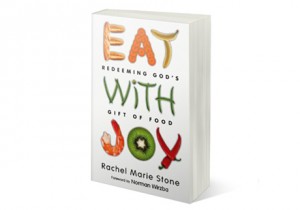It is fitting that I’m writing this review of Rachel Stone’s new book Eat with Joy (InterVarsity Press 2013) while eating lunch at a local French café—an establishment that embodies why Rachel insists on seeing an authentically made French baguette as a gift to be enjoyed, white flour and all, in her generous, thoughtful, creative, challenging, God-centered vision of what food is, and can and ought to become.
 I cannot, in good conscience, actually call this a “review,” as Rachel is a friend with whom I have broken bread on occasion and with whom I have regular online contact. Understand, however, that my glowing response to Eat with Joy is not a concession to a friend’s ego, but rather a testament to why we are friends to begin with. We see so much of the world, including the food on our plates, the meals we prepare for our families, and our culture’s various obsessions and distortions of food, in similar ways.
I cannot, in good conscience, actually call this a “review,” as Rachel is a friend with whom I have broken bread on occasion and with whom I have regular online contact. Understand, however, that my glowing response to Eat with Joy is not a concession to a friend’s ego, but rather a testament to why we are friends to begin with. We see so much of the world, including the food on our plates, the meals we prepare for our families, and our culture’s various obsessions and distortions of food, in similar ways.
In Rachel’s vision, our modern American relationship with food is equally distorted by factory farms, ubiquitous and addictive fast food, pro-ana (anorexia) web sites teaching girls how to starve themselves, and diet gurus who preach a Pharisaic vision of food purity, in which no unclean thing shall pass through your lips. In Eat with Joy, she spends time parsing each of these distortions, and more (including her own history of an eating disorder in which she was convinced that God would be honored by dietary asceticism), as well as their opposites and remedies—the integrity of pasture-fed beef and farmstand produce, the pleasures of home cooking, the healing nature of meals shared with others. She encourages readers not to allow the perfect to be the enemy of the good, to make incremental changes (cooking one or two meals a week from scratch, purchasing a local CSA farm share, inviting the neighbors for dinner) toward eating in ways that are healthier (in a broad sense) for our bodies, the earth, and our communities.
Throughout Eat with Joy, Rachel points us toward a God who gave us food not only for our bodily nourishment, but also for our pleasure and connection with one another.
Surely God could have designed us with some kind of human photosynthetic process, or created our refueling mechanisms in a way that would afford about as much pleasure as I imagine my laptop derives from being plugged into the electrical outlet. I suspect and prefer to believe that God made eating sustaining, delicious and pleasurable because God is all those things and more.
She also reminds us that, just as Jesus used occasions of eating to break down barriers between people and point them toward God, we are called to make choices about food and eating that honor and connect us to other beings, from the animals whose flesh we eat to farm and meatpacking workers and those with whom we dine—our families, neighbors, and strangers.
For someone who has never thought about where her package of discounted hamburger meat came from, has never been to a farmers’ market, or is accustomed to picking up take-out on the way home from work every night, Rachel’s thorough treatment of the problems with modern food production and consumption, and proposed remedies, might be overwhelming. But besides her repeated call to make incremental changes, Rachel also offers a holistic, grounded, and generous approach to healthy eating. This is not a book with hard and fast rules. Rather, it offers a vision for how truly healthy eating (in physical, emotional, communal, and environmental terms) can come about. How such eating will be manifest in each reader’s habits and home is left for him or her to discover, although Rachel offers some suggestions and questions at the end of each chapter for readers to ponder.
This weekend, I was thinking a lot about food, as I finished up Rachel’s book and thought about response to last week’s post on naturopathy and restrictive diets taken on in the name of health.
Saturday night, Daniel and I went out for a rare splurge at a steakhouse in town. While I mostly chose foods that fit into my anti-inflammatory diet (salmon instead of steak, with several different veggie side dishes), the meal was a splurge, financially and dietarily. Recognizing the meal as out of the ordinary, we ate some things we wouldn’t normally eat (we shared a piece of carrot cake, for example) and had real, sustained conversation with one another. It was a healthy meal.
The following afternoon, we took the kids to a nearby park with a maple sugar shack. They collected a huge pail of sap (Daniel, of course, got to carry it back to the shack), then watched as the sap was boiled and listened as the park ranger explained the process. They each got a tiny cup of pure, warm maple syrup to taste. One night this week will be declared pancake night. Ben, whose favorite food is pancakes, will no doubt want to help crack the eggs and stir the wet ingredients into the dry. If I am chief pancake maker, I will probably use part whole-wheat flour, add some flaxseed or wheat germ to the batter. If Daniel takes on that role, he will follow the recipe to the letter, which means pure white flour pancakes. In either case, we will sit down to a meal of pancakes, made with Ben’s enthusiastic help, topped with butter and maple syrup (which is just about as local a food as you can get here in central Connecticut). It will be a healthy meal.
maple syrup to taste. One night this week will be declared pancake night. Ben, whose favorite food is pancakes, will no doubt want to help crack the eggs and stir the wet ingredients into the dry. If I am chief pancake maker, I will probably use part whole-wheat flour, add some flaxseed or wheat germ to the batter. If Daniel takes on that role, he will follow the recipe to the letter, which means pure white flour pancakes. In either case, we will sit down to a meal of pancakes, made with Ben’s enthusiastic help, topped with butter and maple syrup (which is just about as local a food as you can get here in central Connecticut). It will be a healthy meal.
After we returned from maple syruping, I made soup chock full of organic veggies from our weekly co-op delivery and other foods featured in my anti-inflammatory diet—greens, mushrooms, onions, garlic, quinoa, chickpeas. We ate it with honey wheat bread I made the day before in my bread machine (a concession to my arthritis, which makes it hard to stand in the kitchen for lengthy periods of time). That, too, was a healthy meal.
I am grateful to Rachel who, through her friendship and her book, has helped me to understand that healthy meals are not defined solely by which compounds they do or don’t contain, that eating with joy and gratitude means being conscious of the foods we eat, how and with whom we share them, and the God from whose hands it all (the food and the company) ultimately comes.















